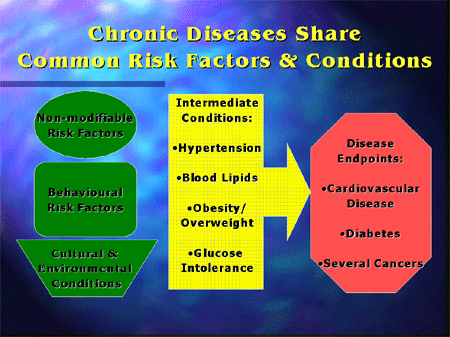|
|
 |
 |
 |
Chronic Disease
What are Chronic and Non-Communicable Diseases?
Chronic (or non-communicable) diseases are typically characterized as having an uncertain etiology, multiple risk factors, long latency, prolonged affliction, a non-infectious origin, and can be associated with impairments or functional disability1. Although chronic diseases are among the most common and costly health problems facing Canadians, they are also among the most preventable. Examples include cardiovascular diseases (heart disease and stroke), cancer, diabetes, arthritis, asthma, and mental illness.
What are the Primary Risk Factors?
According to the World Health Report 2002, the major risk factors include:
- tobacco
- alcohol
- blood pressure
- physical inactivity
- cholesterol
- overweight
- unhealthy diet
In individuals, we can classify the risks factors as follows:
|
- Background risk factors, such as age, sex, level of education and genetic composition;
- Behavioural risk factors, such as smoking, unhealthy diet and physical activity inactivity; and
- Intermediate risk factors, such as serum cholesterol levels, diabetes, hypertension and obesity/overweight
In Communities, the main factors that can impact health include:
- Social and economic conditions, such as poverty, employment, family composition;
- Environment, such as climate, air pollution;
- Culture, such as practices, norms and values; and
- Urbanization, which influences housing, access to products and services.
The following graph depicts the relationship between risk factors, conditions and common disease end-points:

Chronic diseases share common risk factors and conditions. While some risk factors, such as our age, sex, and our genetic make-up, cannot be changed, many behavioural risk factors can be modified, as well as a number of intermediate biological factors including hypertension, being overweight, hyperlipidemia,and glucose intolerance. Societal, economic, and physical conditions influence and shape behaviour and indirectly affect other biological factors. The recognition of these common risk factors and conditions is the conceptual basis for an integrated approach to chronic disease.
1. Pan American Health Organization (2002)
|
![]()







